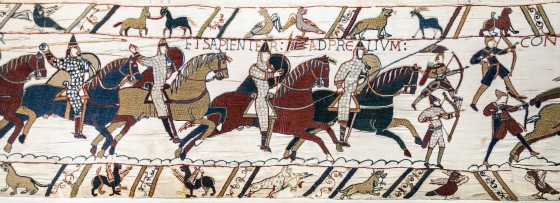Bayeux and the history of men cut from a different cloth

Bayeux is a town in the Calvados department in Normandy, in northwestern France, best known for being the home of the Bayeux Tapestry, which depicts the events leading up to the Norman conquest of England.
Bayeux Tapestry Museum
The Bayeux Tapestry is a document made of cloth that, in a mediaeval version of a comic strip, employs embroidery as the medium for the narrative of the events leading to the conquest of England by the Normans. It is not technically a tapestry, where the pattern is woven into the cloth itself, it is actually an embroidered fabric. Nothing is known for certain about the tapestry’s origins. The first written record of the Bayeux Tapestry is in 1476 when it was recorded in the cathedral treasury at Bayeux as “a very long and narrow hanging on which are embroidered figures and inscriptions comprising a representation of the conquest of England”.
One of the theories affirms that Bishop Odo (William the Conqueror’s half-brother and regent of England when the King was absent) commissioned the tapestry at the same time as the Bayeux cathedral construction in the 1070s, possibly completed by 1077 in time for display on the cathedral’s dedication, and that it was probably designed and constructed in England by Anglo-Saxon artists. French legend maintains the tapestry was commissioned and created by Queen Matilda, William the Conqueror’s wife, and her ladies-in-waiting and is therefore the result of French needlework. A further conspiracy theory argues that the work was planned and embroidered in England and that it contained secret coded messages to undermine Norman rule. Whatever the case, it’s survival over the centuries is no small miracle, and it’s epic length, excellent condition and the fact that some aspects of its origin and some of the details depicted in it are still veiled in mystery make it even more mesmerizing.
The climax of the story depicted on the cloth pivots on the battle of Hastings in 1066. As English and Norman armies fought bravely, King Harold was struck down by an arrow in his eye and killed along with his two brothers. After the battle of Hastings William had an abbey built on the place where the battle had been fought, and the high altar is supposed to mark the spot where Harold was killed.
The truly exceptional character of the Tapestry also lies in its size: it is 225 feet long, 1.6 foot high and weighs close to 772 pounds and depicts 626 human figures, 190 horses, 35 dogs, 506 other birds and animals, 33 buildings, 37 ships and 37 trees or groups and trees, with 57 Latin inscriptions. In 2007 the tapestry was entered into UNESCO’s Memory of the World registry.
The tapestry is reason enough for a trip to Bayeux, but in fact there are two other feasts of archeology and history served up at the same banquet.
Art and History Museum
The newly reopened Le Musée d’Art et d’Histoire Baron Gérard (MAHB) is located in the former living quarters of the dean of the cathedral. It presents artistic, archeological and historical collections as well as paintings by illustrious and lesser-known French painters from neoclassicism to impressionism, porcelain and lace.
Le Musée Mémorial de la Bataille de Normandie
Bayeux was the first French city to be liberated from occupation after D-Day so it is fitting that it houses one of the largest collections in Normandy. The WWII exhibition covers the Allied as well as the German side including uniforms, propaganda material, tanks, artillery pieces, small arms, maps and other items of historical interest.
Museums of Bayeux
Tel : 02 31 92 14 21
Website of the Mairie de Bayeux:
A new website soon to be active:
Facebook page:
Admission: 15 euros – ticket includes access to the 3 museums.
The following video is part of a student project at Goldsmith College reproducing the story told by the Bayeux Tapestry in the form of an animation.
Share to: Facebook Twitter LinkedIn Email
Leave a reply
Your email address will not be published. Required fields are marked *




REPLY